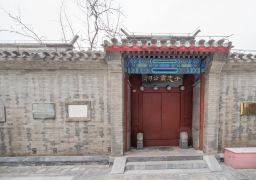This three-room, two-story small western-style house, built in 1930, is named ‘Small Western-Style House’ due to its compact structure and the use of cement, also known as ‘foreign lime’. It is also called ‘Shengxi Xiaozhu’ and ‘Han Zhai’. Located to the east of Wenchang Pavilion, it is connected to the pavilion by an open-air corridor.
In April 1937, after Chiang Ching-kuo returned from studying in the Soviet Union, Chiang Kai-shek arranged for him to live and study here, where he supplemented his Chinese studies, read works such as the family letters of Zeng Guofan, the complete works of Wang Yangming, and ‘National Language Legacy’, and wrote ‘Travel Report from Russia’, reflecting on the red mark left by his studies in the Soviet Union, and ‘brainwashing’ his son. Chiang Ching-kuo described it in his diary as ‘Han Zhai’, humorously comparing it to a ‘study for cultivating one’s body and mind, and increasing one’s cultivation’. When Chiang Ching-kuo lived and studied here, the east side of the upstairs was the bedroom, the west side was the study, and the middle was the living room.

The Small Western-Style House has also been home to Chiang Kai-shek’s foreign military advisor, T.V. Soong, and the director of the staff, Chen Bulei. Inside the first floor of the Small Western-Style House, there is a stone tablet inscribed with ‘Wash Blood with Blood’, which tells the historical story of the misfortune of Chiang Ching-kuo’s mother, Mao Fumei. On December 12, 1939, Japanese aggressors bombed Xikou, and Mao Fumei was unfortunately crushed to death by the collapsed back wall at the back door of Fenghao House. Upon hearing the news, Chiang Ching-kuo rushed from Jiangxi to mourn, and in his grief and anger, he wrote the four characters ‘Wash Blood with Blood’, expressing his firm determination to avenge his mother’s death.
The Small Western-Style House
This three-room, two-story small western-style house, built in 1930, is named ‘Small Western-S[...]









